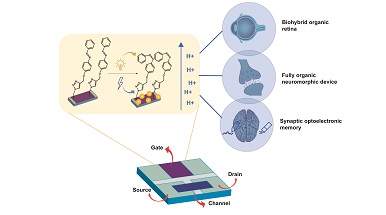
A material that behaves like our eyes and remembers like our brain: this is the discovery of a successful team of researchers from the Italian Institute of Technology, Federico II University of Naples and RWTH University of Aache. The team worked on the synthesis of a new organic material that is conductive and sensitive to light which, when appropriately stimulated, imitates the behaviour of the retina but also memory processes in the brain.
The results of the research, carried out by the international team led by researcher Francesca Santoro, Professor of RWTH Aachen University, were published in the prestigious journal Nature Communications (Impact factor 16.6 - 2022 Journal Impact Factor, Journal Citation Reports (Clarivate Analytics, 2023)) in the article “Azobenzene-based optoelectronic transistors for neurohybrid building blocks” (doi: 10.1038/s41467-023-41083-2).
How can a synthetic material imitate the functioning of organs in the human body?
«The development of new organic materials capable of simulating the behaviour of our body's cells represents an innovative path for medical-engineering progress. The material we have developed is able to understand how much light interact with it by giving us an electrical signal back, in a very similar way to what happens in our eyes. - explains Ottavia Bettucci, now researcher at the Department of Materials Science at the University of Milano - Bicocca and reference author of this research. – Furthermore, our material also has the ability to remember the light stimulus in a way that is very similar to what happens in the memory processes of our brain».
The devices, made with this completely organic and non-toxic material work through the exchange of charged species: ions. This is exactly what a biological system does to control certain processes and exchange information. These features allow for better integration into biological systems compared to traditional silicon devices, which are rigid and work via electron exchange.
What applications might these materials have in the future?
«This innovative chip could correct eye and brain malfunctions in the future. Indeed, light irradiation modifies the conductivity of the material, both short and long term. - continues Dr. Bettucci. - This behaviour means that the chips also function as an artificial synapse which in fact in nature transmits electrical signals, changing, for example, their intensities and their efficiency. These processes underlie our brain's ability to learn and remember».
Although the work is still a "proof of concept", in a future perspective these devices could correct errors in the processing and transmission of information that occur in neurodegenerative diseases such as Parkinson's or Alzheimer's, or support organs that no longer work properly.
These are not the only possible applications: there is also an aspect linked to information technology. In fact, thanks to their optoelectronic properties, the chips can work as hardware for artificial neural networks. So far, artificial intelligence programs work by imitating the self-learning principle rather inefficiently. Thanks to the unique properties of this material, the operating mechanism of an electronic memory can be reproduced. «By alternating light pulses with electrical ones, we observed a “writing-erasing” mechanism of the signal. The chip therefore behaves like an efficient optoelectronic memory which remains consistent with the behavior of biological neurons» – concludes Dr. Bettucci.
This work that brought together chemistry, engineering and biology represents an example of how technology can combine multiple disciplines to help us solve problems that, at various levels, are present in our everyday lives.